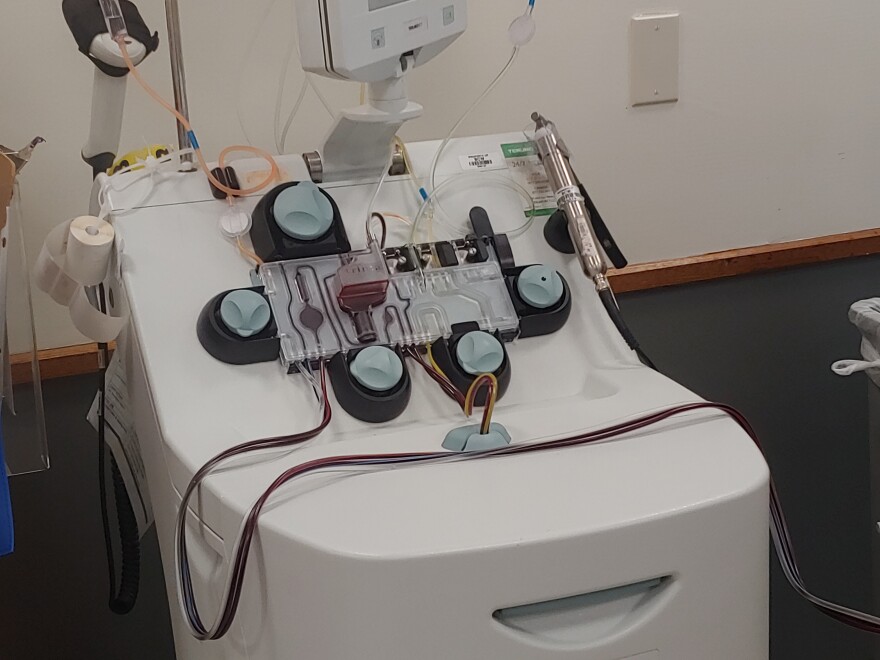On Monday, Dr. Dave Lal donated plasma for the third time in recent weeks at the Versiti Blood Center of Wisconsin in downtown Milwaukee.
Lal sat quietly in a recliner as a machine called an automated blood collection system took blood and its liquid component plasma out of his body, before returning the blood cells.
>>Latest WUWM & NPR Coronavirus News
But this was no ordinary plasma donation. Lal, a pediatric surgeon at Children's Hospital and the Medical College of Wisconsin, says he recovered from COVID-19 about a month ago after antibodies in his plasma apparently helped fight off a mild case of the disease.
"I hope my body has developed antibodies and that I have an excess number of them. I can help other people that are in a position that need it and they are critically ill, and there's nothing else to offer them," Lal told WUWM.
By "other people," Lal means certain COVID-19 patients. The Blood Center and some Wisconsin hospitals are taking part in a national effort to try to see if giving convalescent plasma — plasma from people now shown to be free of COVID-19 — to active patients can be one way to return them to health.

Dr. Jerry Gottschall, a senior medical director at Versiti, says it's not a new concept.
"It goes way back in flu. It was used in the SARS outbreak, for Ebola. What it does is ... by attacking the virus, getting rid of the virus, lowering the amount of virus in the body of the patient, that will reduce the impact the virus is creating," Gottschall said.
Gottschall says it'll be another month or two before researchers know if convalescent plasma actually affects COVID-19 patient outcomes. Also, which patients — in terms of their age, any underlying conditions, at what point in COVID-19 they're given the plasma transfusion.
For a snapshot of where things stand now, we spoke with doctors from three Wisconsin health care agencies using the plasma. Dr. William Hartman is the primary investigator for the project at UW Health in Madison, where 10-15 patients have received transfusions.
"There have been various degrees of recovery. Some patients that we are able to treat early on, we were able to prevent them from having to go to the ICU [Intensive Care Unit], or onto a ventilator. Other patients that were more advanced in their disease, we've treated some. Some have progressed quite nicely, others have progressed more slowly," Hartman said.
"It's never been studied, so I can't say definitively that it's making a difference. Anecdotally, we feel that it's benefitted our patient and if you look at convalescent plasma's history, people seem to feel that it anecdotally helps." - Dr. Ajay Sahajpal
Dr. Ajay Sahajpal says one patient at Advocate Aurora Health has received convalescent plasma, and the man's COVID-19 symptoms seem to be weakening.
"But it's never been studied, so I can't say definitively that it's making a difference. Anecdotally, we feel that it's benefitted our patient and if you look at convalescent plasma's history, people seem to feel that it anecdotally helps," Sahajpal said.
At Froedtert Hospital in Wauwatosa, where Dr. Mary Beth Graham is the medical director of infection prevention and control, she says five critically ill patients have received the plasma.

"Many of the patients, you know, as I look at them, and I've got their numbers right here, their oxygen requirements have improved. But they're still quite ill, because, again, we treated them at the point where they were exceptionally ill, in the ICU's when we were contacted and we were able to get the product for them," Graham said.
Getting the product, aka the plasma, appears to be one of the biggest challenges for the convalescent program. The doctors say if donors had a diagnostic test showing they had COVID-19, they must then have gone 28 days without symptoms, or 14 days without symptoms if they later had a negative test for the disease.
Sahajpal is glad to hear that Lal, of Children's Hospital, donated plasma a third time. Sahajpal says a typical plasma donation of 600 mL, which is a little more than a pint, can serve three COVID-19 patients.
"I personally have a patient who's waiting for plasma where there isn't any. And so, likely this donation will generate plasma units that will benefit our patient. But there are several waiting, across both Wisconsin and Illinois," Sahajpal said.
All the doctors WUWM interviewed urged more recovered COVID-19 patients to come forward. Froedtert's Graham, who's also a professor at the Medical College of Wisconsin, says if enough people donate plasma, a Froedtert study that's underway should help future patients with a more targeted effort.
"Could somebody make a specific monoclonal antibody therapy for this? Or, are there other things where we say, OK, this is the type or immune response that is most beneficial. So this is another way when I'm looking at vaccine trials, what kind of response do I want to see?" Graham wondered.
Many researchers around the world are trying to develop a COVID-19 vaccine. But that vaccine could be a long way away. In the meantime, the question is: can convalescent plasma truly be of help?
During this pandemic, WUWM's Bubbler Talk is focusing on the coronavirus and its impact on the Milwaukee area. If you have a question, submit it below.
_





